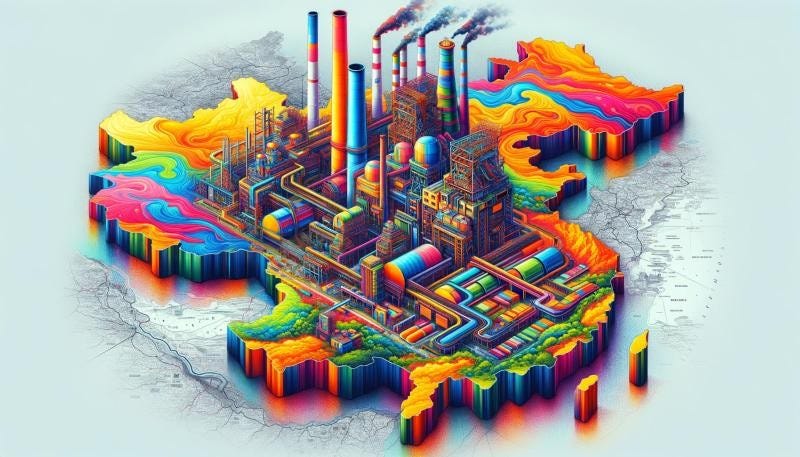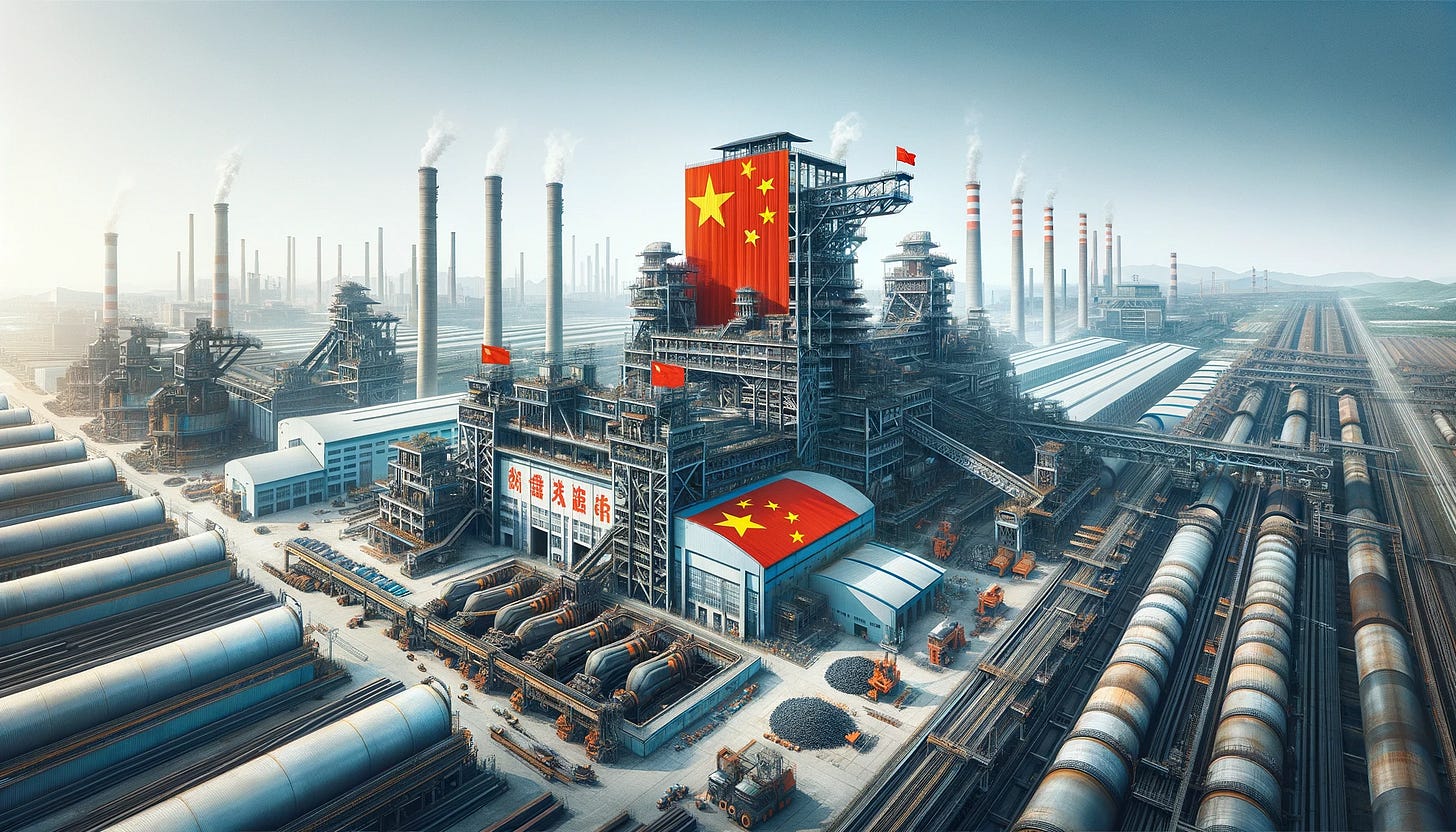#1: Decoding The Dragon's Steel Resolve
Imagine skyscrapers taller than Mount Everest, bridges stretching across rivers and oceans, and cars lighter than feathers – All built on a foundation of steel!
China's steel industry is a titan, churning out over 1 billion tons annually – that's more than half the world's production capacity, which is good enough to build ten steel replicas of the Mount Everest every single year.
Buckle up, folks, because we're about to plunge into the fiery furnace of China's steel dominance, meet the behemoths shaping this metallic landscape, and explore the forces driving this industrial inferno.
..
Before we move ahead, do join my 17k member big Biz News+ community on WhatsApp.
..
The Rise of a Steel Giant: A Chronological Tale
Early 20th Century: China's steel industry was a fledgling sector, sparse and underdeveloped, especially during the World Wars when much of its infrastructure was destroyed.
1953-1957: The First Five-Year Plan of the Chinese Communist Party marked the beginning of China's focused industrial development, with steel production being a top priority. However, the growth was slow, often bottlenecked by limited production capabilities.
Post-1978 Economic Reforms: The reforms spearheaded by the iconic Chinese President Deng Xiaoping ignited rapid industrialization, revolutionizing the steel industry. By 1996, China's annual crude steel output reached 100 million tons.
..
21st Century Surge
Entering the 21st century, China's steel production underwent explosive growth. The industry shifted towards serving both local manufacturing needs and international markets.
Through consolidation and technological advancements, China's steel giants like Baosteel and Shougang Group solidified their global dominance.
By 2010, China's steel production had skyrocketed to over 600 million tons annually, signalling its ascent to global leadership in the industry.
And with sustained growth, as of the present day, that has further grown past a billion tons a year mark.
As a result, China today accounts for 55% of the global steel production capacity, which gives it the absolute supply-side clout to determine the price of steel all over the world.
..
There is One Special Thing About This Whole Thing- The Regional Concentration.

The province of Hebei alone accounts for ~30% of all Chinese steel production capacity
And in that province, the city of Tangshan alone holds a making capacity of a whopping 120 million tons a year
That’s enough to provide for all of India’s steel consumption today. Fully!
Also, if each of the Chinese cities with steelmaking capacity were to be seen as a separate company, we would have 14 steel majors bigger than any in India, whether we compare them to JSW Steel, Tata Steel or whosoever else. Picture that!
..
The Titans of Steel: Major Players and Global Standing
But beyond the cities, what we have is these giant colossal enterprises, who make the world look small.
Leading the pack, we have Baowu Steel Group which boasts of a 125 million ton of annual capacity dwarfing even the largest US and Indian steelmakers- Minimum 4.5x larger. Imagine a dragon guarding a mountain of iron ore, its scales forged from the fires of industry. That’s Bouwu!
Then there are the likes of HBIS, Jianlong, Shagong and Ansteel, which have capacities of roughly 70, 40, 45 and 40 million tons respectively.
These giants are not just national champions but formidable players on the world stage, competing with global giants and often setting the pace in the industry.
..
Global Industry Impact

China's massive Overproduction and export capabilities have led to a global steel glut, impacting profitability and environmental sustainability way beyond the Chinese shores.
Fluctuations in China's steel output or policy changes can lead to ripple effects in global markets, impacting prices and availability.
Conversely, it also sometimes opens up opportunities for global competitors, especially Indian ones to fill gaps in the global market.
Thus, in a big way, it is the players in China, who practically determine, how much their Indian or American competitors are going to earn every quarter.
Thus, China's steel industry is not just a national powerhouse but a global force that influences markets, politics, and economies worldwide.
Its strategies, from expanding green steel production to fostering mega-mergers, set trends that reverberate across continents.
..
2023 and Beyond: The Current State and Future Prospects
Consolidation for Global Dominance: A significant policy shift involves encouraging mergers and acquisitions to create world-class steel conglomerates. This strategy aims to centralize the fragmented industry and boost its global competitiveness. A notable example is the merger of Ansteel and Ben Gang Group Corp, creating the world's third-largest steelmaker.
Greater Value Addition: The Chinese Ministry of Industry and Information Technology (MIIT) is increasingly pushing the manufacturing of value-added steel products, to enhance the value generated for the Chinese economy.
Threat of Trade Tensions: Trade protectionism and geopolitical challenges disrupt supply chains and threaten China's steel exports. Think tariff walls rising like steel barriers, casting shadows on the free flow of metal.
Environmental Scrutiny: Steel production is notoriously carbon-intensive, raising concerns about air pollution and climate change. China faces international pressure to innovate towards cleaner steelmaking processes and reduce its carbon footprint. However, China is responding with technological innovation, green initiatives, and support for electric furnace development.
Challenges and Innovations: The sector faces challenges like weak demand from traditional sectors like real estate and profitability issues.
..
Comparative Perspective: India and the US
To put China's steel-making might into perspective, consider this: In 2023, India produced around 120 million tons of steel, while the US produced approximately 86 million tons. In contrast, China's production was nearly nine times that of India and over twelve times that of the US, highlighting its colossal scale and impact.
..
Conclusion
Think arteries of steel pumping life into economies across continents.
China's steel fuels its massive infrastructure projects, from the Belt and Road Initiative to its bullet train network, shaping the global landscape with its metallic veins
They are like cogwheels turning the wheels of the world's factories, powering countless downstream industries, from construction to manufacturing, that make China a global powerhouse in diverse sectors
It has far-reaching implications for global steel markets and its production capacity, policies, and innovations set trends that resonate across international borders, influencing pricing, supply, and quality standards worldwide
..
Subscribe and stay tuned for more updates in this fascinating saga of studying China’s rise!
See you tomorrow morning 7.30 am with another edition.
Best,










Sir very nice and informative perspective , keep doing it so much to learn and really appreciate this and wonders because they are completely free , blessing to you,keep it up and help newbies to understand , I joined your WhatsApp group please share the ARTICLES THERE